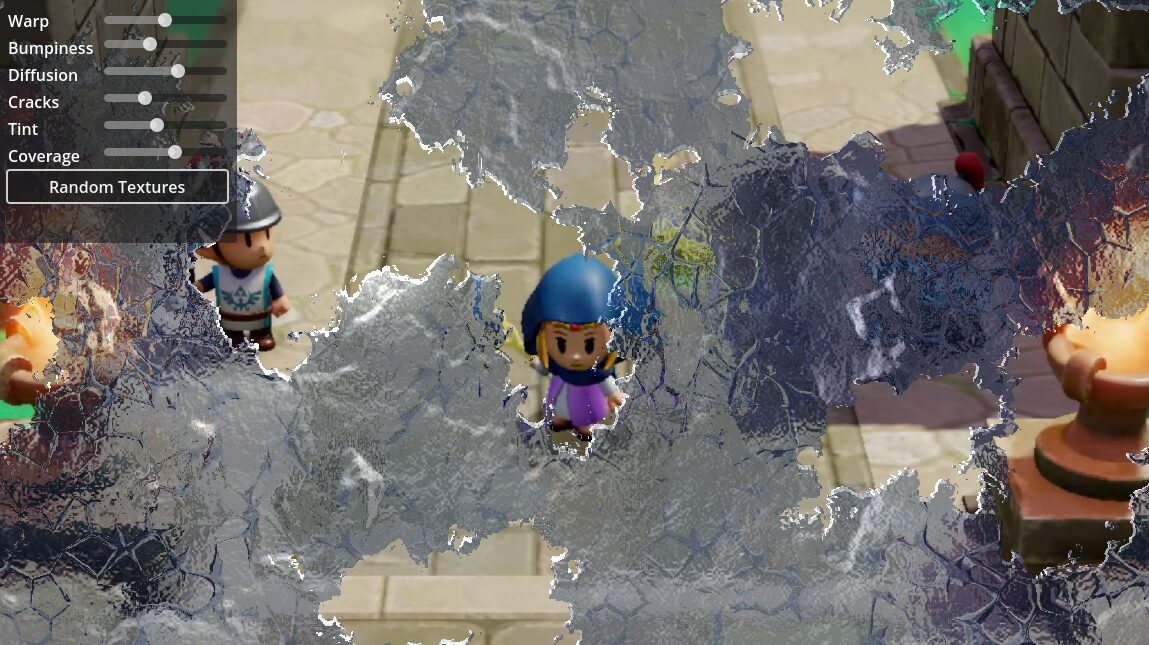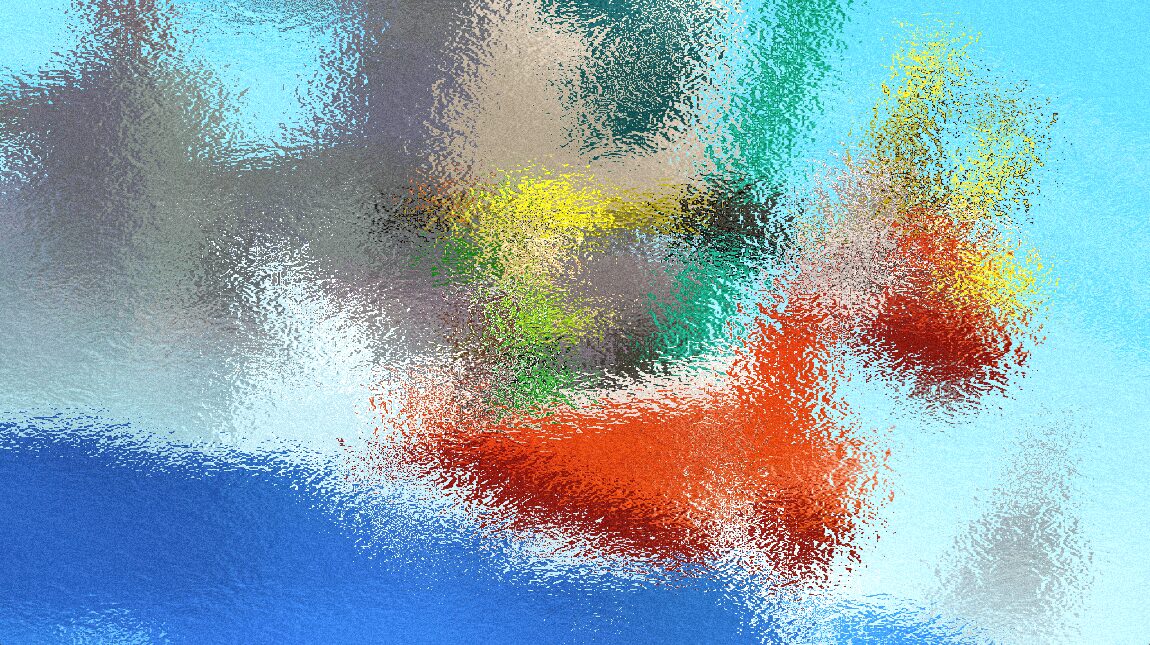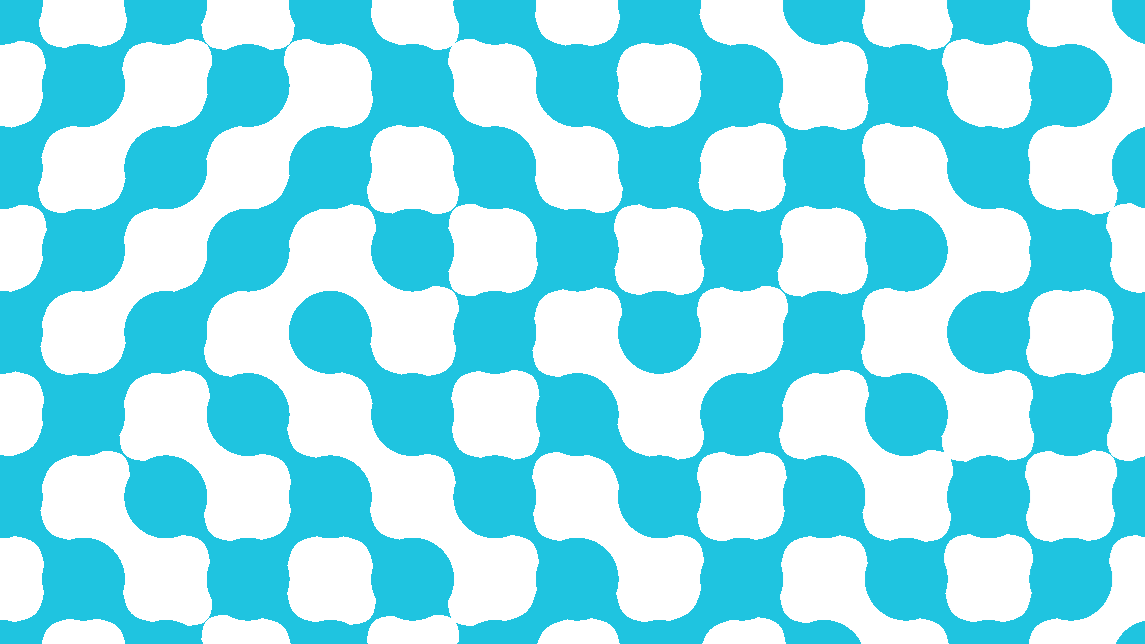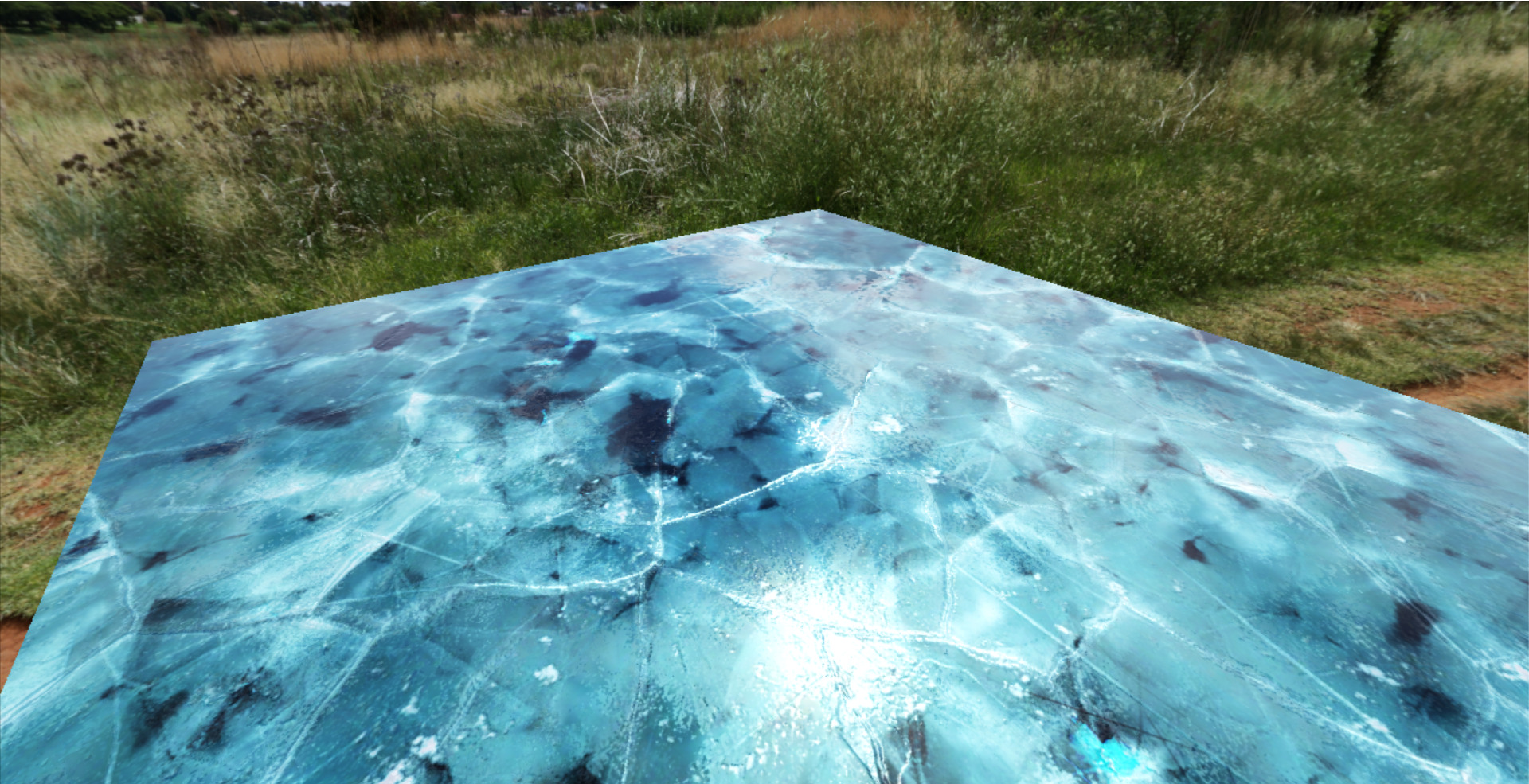Ice Covering
Covers whatever is behind it in a layer of ice. You’re given full control of the effect, including warping, tint, cracks, bumps, lighting highlights, etc.
Includes gdscript for generating noise textures.
Shader code
/*
Copyright Nathanael C. Fritz 2024
License MIT
*/
shader_type canvas_item;
// mipmap is neaded for textureLod
uniform sampler2D screen_texture: hint_screen_texture, repeat_disable, filter_nearest_mipmap;
// see bottom for texture/normal FastNoiseLite generators
// used with coverage uniform to determine where to show ice
uniform sampler2D coverage_texture: repeat_enable;
// used for coloring cracks
uniform sampler2D crack_texture: repeat_enable;
// used for distorting light through cracks
uniform sampler2D crack_normal: repeat_enable;
// used for extra surface highlights
uniform sampler2D bump_normal: repeat_enable;
// used for distorting light and bumpy surface highlights
uniform sampler2D warp_normal: repeat_enable;
// mouse pointer light
uniform vec2 pointer = vec2(1.0, 1.0);
// ice coverage threshold
uniform float coverage: hint_range(0.0, 2.0) = 0.5;
// distortion behind ice
uniform float distort: hint_range(0.0, 0.3) = 0.01;
// how bumpy is the surface of the ice
uniform float bumpiness: hint_range(0.0, 1.0) = 0.8;
// emphasis of crack distortion and color
uniform float crack_intensity: hint_range(0.0, 1.0) = 0.5;
// how bright should light highlights be
uniform float diffusion: hint_range(0.0, 1.0) = 0.8;
// what color should we be tinting? usually a dark blue
uniform vec4 tint_color: source_color = vec4(0.025, 0.139, 0.36, 1.0);
// how strong should the tint be
uniform float tint_amount: hint_range(0.0, 1.0) = 0.4;
vec2 generate_normal(sampler2D in_texture, float threshold, vec2 uv, vec2 pixel_size) {
// Sobel operator to detect edges on the thresholded texture
pixel_size *= 3.0;
float scale = 0.85;
// poor man's normal, using our threshold edges
float left = step(threshold, texture(in_texture, uv + vec2(pixel_size.x, 0.0)).r);
float right = step(threshold, texture(in_texture, uv - vec2(pixel_size.x, 0.0)).r);
float down = step(threshold, texture(in_texture, uv + vec2(0.0, pixel_size.y)).r);
float up = step(threshold, texture(in_texture, uv - vec2(0.0, pixel_size.y)).r);
float horiz = (right - left) * scale;
float vert = (up - down) * scale;
vec3 norm = normalize(vec3(horiz, vert, 0.4));
return norm.xy;
}
void fragment() {
// our UV is probably not square
// so we correction the ratio and only use the original UV for sampling
// the screen background
float ratio = SCREEN_PIXEL_SIZE.x / SCREEN_PIXEL_SIZE.y;
vec2 uv = vec2(UV.x, UV.y * ratio);
// correct our mouse position
vec2 shine_pos = pointer;
shine_pos.y *= ratio;
// get our warp normal for distorting the background
vec2 warp = texture(warp_normal, uv).xy - 0.5;
// we need to dynamically generate a normal for our coverage because the edges
// are dynamicly set by "coverage"
vec2 coverage_normal = generate_normal(coverage_texture, coverage / 2.0, uv, SCREEN_PIXEL_SIZE);
// scale by bumpiness
warp *= bumpiness;
// sample the coverage texture to determin where ice will be
float area = texture(coverage_texture, uv).r;
// generate a threshold
// we can now multiply our ice effects by "effects" which is a 1.0 or 0.0
// disabling our effects for any pixel outside of the ice
float effect = step(area, coverage / 2.0);
// set a threshold where cracks can be
float show_crack = mix(0.0, 1.0, step(area, coverage - 0.5));
// set a higher threshold for where cracks are colored instance
float color_crack = mix(0.0, 1.0, step(area, coverage - 0.7));
// sample our bump normal
vec2 bump = texture(bump_normal, uv).xy - 0.5;
warp += bump * min(3.0, 6.0 * bumpiness);
warp.x *= -1.0;
// sample our crack normal and crack texture
vec2 crack = texture(crack_normal, uv * 2.0).xy - 0.5;
float crack_sample = texture(crack_texture, uv * 2.0).r;
// make a circle of light at the mouse position
float shine = smoothstep(0.1, 0.0, distance(uv, shine_pos));
vec2 lightDir = -normalize(shine_pos - uv);
// get our light diffuse value
float diffuse = max(dot(warp + coverage_normal, lightDir), 0.0);
// mask cracks based on diffuse value
show_crack *= abs(diffuse - 0.5);
// final calculation of the distortion effect
// of ice and cracks
vec2 uv_offset = SCREEN_UV + (warp * effect * distort)
+ (crack * show_crack * effect * crack_intensity);
// sample background from distorted viewpoint
// basic LOD blur as well
vec4 screen = textureLod(screen_texture, uv_offset, effect * distort * 5.0);
// tint ice affected pixels
screen = mix(screen, tint_color, tint_amount * effect);
// apply diffusion based on intensity
// apply a spotline shine, and increase diffusion under shine
screen.rgb += diffuse * effect * (diffusion + shine);
screen.rgb += shine * 0.5 * effect;
// yarp
COLOR = vec4(screen);
}







